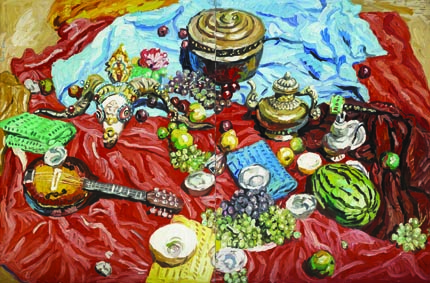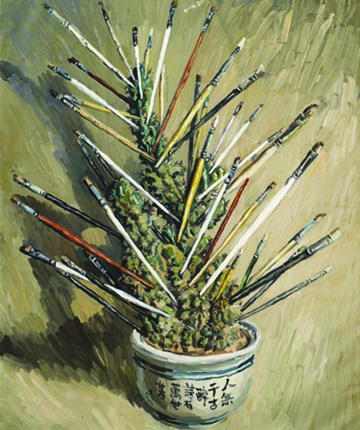QIN QI: BACK AT ONE
| July 18, 2012 | Post In LEAP 15

QIN QI HAS done fewer and fewer large-scale works over the past two years, essentially changing his form of practice since the art world first became familiar with him. Looking back to the start of 2005, Qin’s large-scale works appeared frequently in all sorts of contemporary art exhibitions. At that time, regardless of whether the artist was Qin or not, creating huge works was actually a trend in Chinese contemporary painting, the reasons for which no doubt included artists’ conceit toward their own painting ability. But among these artists, there were also those who shared tacit understanding of a competitive mentality within the industry— in the exhibition hall, large scale works easily captured attention.
The trend was more toward an instinctive, spontaneous approach to art practice. But to Qin Qi, a few years after graduating from the Lu Xun Academy of Fine Arts in 2002, this pure painter’s competitive nature caused his artistic practice to take on a kind of suspenseful, unresolved quality. Looking back now, Qin’s working method at the time seemed to be an exercise in trial and error with different painting methods. He was not trying to establish a stable body of language for himself so much as figure out the possible linguistic representations of all of the things that interested him. Qin was honest to admit this had something to do with engaging Wang Xingwei. No matter whether it was the language of painting, or the selection and establishment of thematics he continuously consulted and flitted between different approaches to painting, folding the imaginative powers that he had previously given free expression to into his work of creating concrete, material forms. So, if Qin’s earlier period looks like a painting practice with absolutely no sense of direction, in reality it was a period of strenuous training. Its impact on the painter himself was not only to foster diversity in the character of his works, but also to give him the ability, through the selection of painting experiences, to distill his own judgment.
Qin Qi’s Captain (2006) is a work that is mandatory to discuss, not for its formidable dimensions, but rather for its representation of that which Qin’s works stand for: utilizing the perspective of still life to construct a painting. In the “Chair” series (2005) he did before Captain, Qin portrayed this everyday object in several different ways. Quite simply, in this series of paintings the uncertain uses that exist in implements from different daily life settings can completely extricate themselves from the medium of painting, the notion becoming clear directly through the image itself. So, in the “Chairs” series, these abrupt notions take the debasement of painting as a method of representation.

But clearly, Qin Qi is inspired by “objects,” allowing Captain to achieve a singularly calm and impassive visual rhetoric. Captain is a fictional, abnormal setting, but in a visual sense, it is very normal: a cluster of plaster casts in the classical style, thick smoke, a pommel horse, a ruined ship, a frog-shaped garbage bin, a police car, a one-story house and a courtyard enclosed by an outer wall and three palm trees, and so on. The arrangement of these objects lifted from real life is similar to the relationship of the forms of the apples, bananas, pitcher and tablecloth in a still life painting. Not only have nearly all of Qin’s objects been depicted at close range, but even the one-story house in the long shot seems this way because its white color leaps out at the eyes. Moreover, the whole scene has been set up under bright sunlight, with the dominant white tones again confirming the demands of the painting’s planar form and the materiality of the pigments, indicating both durability and weight. What is interesting is that in a visual sense the thick smoke divides the scene in two: in syntax, it appears more or less like a mass of clouds in a classical oil painting with a mythological theme, reinforcing the surreal quality of the whole painting. At the same time, the painting’s large dimensions call to mind historical paintings in the classical style.
Because of their position in the still life genre painting, objects can easily be arranged on the same picture plane on the basis of the demands of form. From this perspective, Qin Qi differentiates between new focal points of form: similarity and a close visual angle. The material layer that exists in “similarity” also exists among forms. For example, the earthen hill in The Fairy Palace (2006) and the white pigment and the cheese in Cheese (2007) are all associations with the material characterization of color. But in Leather Belt and The Tortoise (2007) Qin humorously points out the interchangeability of the snake and the leather belt in terms of form. His close-range perspective resembles the traditional visual angle used in the still life genre. The reason Qin chose to do it this way was to avoid creating depth of field, thereby maintaining the integrity of the painting’s planar form. In his large-scale paintings, images are generally crowded into the foreground. At times, this visual angle also creates theatrical visual effects, such as in White Radish (2007). Because of the use of the close-range perspective, which looks down on the image, the white radish no longer resembles a humble piece of produce, but rather morphs into a colossus looming over the entire earth, endowed with a sense of lofty superiority. But these works all possess the same over-arching characteristic: one after another, the images have all been placed in a pile of colors, using the materiality of the colors to withstand the pictures’ corrosion of the medium of painting.

Qin Qi’s newest 2012 exhibition “Oxidize” is the artist’s first showcase of still life paintings. In terms of linguistic representation, this collection of works, mostly completed between 2010 and 2012, in no way betrays the positive energy of his previous still life paintings. The language of the paintings returns once again to a certain origin. Qin seems apprehensive of consciously responding to painters because of the historical consequences of methodological competition. This is an intrinsic apprehension, similar to that depicted in the exhibition’s Stabbed Paintbrushes (2010), featuring a potted cactus with oil painting brushes stuck into it. Yet the inscription on the cactus’s pot reads “Wan Shi Fang [Everlasting Aroma]”— at least from Qin’s perspective, the paintbrush’s intractability exists because the immediate parallel to the history of painting is the history of modeling methods. Of course, the amount of space the history of painting reserves for contemporary artists is next to nothing. Looking at it from this perspective, what Qin brings forth through the still lifes in “Oxidize” is his own understanding of painting, a constant that remains undiminished after myriad transformations.
In his newest still lifes, Qin Qi returns once again, like in a flashback, to the internal form of painting. The goal is not so-called “creation” or rhetoric, but to achieve precision with regard to reproduction. For example, in the bamboo tubes and the canvas cloth in Canvas (2011), Qin was not merely recalling the similarity between the images but was actually re-creating the respective objects of the bamboo and the canvas through the relationship between the brushstrokes and the hues. Similarly, Qin’s intent is evident in a series of paintings that take meat as the subject. This is especially the case in Small Piece of Meat (2010). Qin painstakingly recreated a cross-section of pork, displaying the different layers of the meat from outside to in. In some of his other paintings, he maintains this certain devotion to striving for a visual sense of abundance and enthusiasm. This comes from his studies, when Van Gogh’s works influenced his aesthetic tastes. But when faced with a still life, Qin does not have the same preference for just letting things be. Instead, he uses the customs and ambience of the western regions of China to establish a visual textual logic, such as in Sheep Skull (2010), which is permeated by the impact of the material and the formal. Compared with this, the restraint and calm that Apples Going Downstairs (2012) embodies stems entirely from the reappearance of a sense of space.
In reality, Qin Qi’s technique in this collection of still lifes adheres almost entirely to a regularity of form; even the backgrounds of the paintings are painted in this manner. To Qin, it is clear that every still life is a concrete form; no general sense of the “painterly” exists. When he brings his paintings back to a certain origin, it is because he knows that any review of painting must begin with self-reflection— the true source of painting’s vitality.

